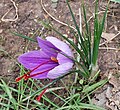Crocus sativus
| Saffron crocus | |
|---|---|

| |
| Flowers showing crimson stigmas | |
| Scientific classification | |
| Kingdom: | Plantae |
| Clade: | Tracheophytes |
| Clade: | Angiosperms |
| Clade: | Monocots |
| Order: | Asparagales |
| Family: | Iridaceae |
| Genus: | Crocus |
| Species: | C. sativus
|
| Binomial name | |
| Crocus sativus | |
| Synonyms[1] | |
| |
Crocus sativus, commonly known as saffron crocus or autumn crocus,
Common names
The plant is most commonly known as the saffron crocus. The alternative name autumn crocus is also used for species in the Colchicum genus, which are not closely related but strongly resemble the true crocuses; in particular, the superficially similar species Colchicum autumnale is sometimes even referred to as meadow saffron. However, the true crocuses have three stamens and one style supporting three long stigmas, while colchicums have six stamens and three styles; and belong to a different family, Colchicaceae. Colchicums are also toxic, making it particularly crucial to distinguish them from the saffron crocus.[3][4]
Description
Crocus sativus is a perennial herb Saffron crocus is a 
Genetics
Domestication
It is thought that the domesticated saffron crocus most likely arose as a result of selective breeding from the wild C. cartwrightianus in the southern portion of mainland Greece.[14] An origin in Western or Central Asia, although often suspected, is not supported by botanical research.[16]
Uses
The
Cultivation
As a sterile triploid, C. sativus is unknown in the wild and relies upon manual vegetative multiplication for its continued propagation. Because all cultured individuals of this plant are clonal, there is minimal genetic diversity from the single domestication event, making it quite hard to find cultivars with new, potentially beneficial properties, let alone combine them by breeding.[21] Cultivars of saffron are nevertheless produced by a number of means:[22]
- Clonal selection. Any plant with a desirable mutation is kept and further grown. This is the traditional approach.
- Mutation breeding. Mutagenesis can be used to cause a wide range of mutations to select from. The traditional clonal process follows.
- Sexual reproduction. Breeding for desirable features is much easier in fertile plants.
- Although the plant is not self-fertile, some wild relatives can be successfully cross-pollinated with saffron pollen in vitro and form seeds. This creates fertile diploid plants containing genomic material from C. sativus, allowing new traits to be explored via further cross-pollination.[22]
- Chromosome doubling could in principle also create a fertile hexaploid plant. Such a change may be possible via colchicine.[23]
Corms of saffron crocus should be planted 10 cm (4 in) apart and in a trough 10 cm (4 in) deep. The flower grows best in areas of full sun in well-drained soil with moderate levels of organic content.[24] The corms will multiply after each year, and each corm will last 3–5 years.[20]
Gallery
-
Illustration from Köhler's Medizinal-Pflanzen (1897)
-
Flower's profile, Serra de Casteltallat, Catalonia, Spain
-
Pollen, Afghanistan
-
styles and stigmasof C. sativus.
See also
- History of saffron
- Trade and use of saffron
References
- ^ "The Plant List: A Working List of All Plant Species". Retrieved 23 April 2015.
- ^ a b "Crocus sativus". Germplasm Resources Information Network. Agricultural Research Service, United States Department of Agriculture. Retrieved 23 April 2015.
- ^ Bowles, E. A. (1952). A Handbook of Crocus and Colchicum for Gardeners. D. Van Nostrand Company, Inc. p. 154.
- ^ "Colchicum autumnale | meadow saffron/RHS Gardening".
- ISBN 9783031100000.
- ^ Mollazadeh, Hamid "Razi's Al-Hawi and saffron (Crocus sativus): a review". Iranian Journal of Basic Medical Sciences, Dec 2015.
- ISBN 978-1-57808-427-2.
- ^ a b "Crocus sativus (Autumn Crocus, Saffron, Saffron Crocus) | North Carolina Extension Gardener Plant Toolbox". plants.ces.ncsu.edu. Retrieved 15 July 2023.
- PMID 22131743
- PMID 19772674.
- ^ PMID 23123733.
- ^ PMID 30690735.
- S2CID 49409790.
- ^ doi:10.1101/537688.
- S2CID 89990377.
- S2CID 7577712.
- ^ a b "Crocus sativus - Plant Finder". www.missouribotanicalgarden.org. Retrieved 15 July 2023.
- PMID 36678554.
- ISBN 978-0-471-21423-6.
- ^ a b "Saffron Farming Information Guide". AgriFarming. 8 August 2015.
- PMID 26138822.
- ^ S2CID 208574298.
- ^ Aqayef, Yusof; Fathi, Mohammad; Shakib, Ali Mohammad (2007). Investigation of possibility of obtaining hexaploid saffron forms through treatment of plants by colchicine (Report) (in Persian). Agricultural Biotechnology Research Institute of Iran.
- ^ "Growing and Harvesting Saffron Crocus". White Flower Farm.
External links
 Media related to Crocus sativus at Wikimedia Commons
Media related to Crocus sativus at Wikimedia Commons





